| River Ching | |
|---|---|
 | |
| Location | |
| Country | England |
| Physical characteristics | |
| Mouth | |
• location | River Lea |
The River Ching is an urban river in northeast London, England, which flows southwest from Epping Forest through Chingford to join the River Lea.
| River Ching | |
|---|---|
 | |
| Location | |
| Country | England |
| Physical characteristics | |
| Mouth | |
• location | River Lea |
The River Ching is an urban river in northeast London, England, which flows southwest from Epping Forest through Chingford to join the River Lea.
The Ching originates as a small stream from a spring at the foot of a tree in the southern part of Epping Forest, and flows through woodland and across a ride, coming to the Connaught Water over a fine gravel bed; the flow is not always strong enough to flow continuously to the lake. The Water - which was created by damming the Ching - lies in the parishes of Loughton and Waltham Abbey. Exiting the lake through a sluice, the small river [1] curves towards Rangers Road. Early in this stretch it is joined by the Cuckoo Brook, [1] from Ludgate Plain, northeast of Sewardstonebury, which also takes in a stream from Chingford Plain. Beyond Rangers Road, the Ching flows south and then southwest, to Chingford Hatch, in a semi-woodland setting, and largely in natural banks but with some concrete embankment. [2]

In the Highams Park area of Chingford, damming of the Ching created a boating lake about two centuries back, on the grounds of a manor house, and as part of a landscape plan by Humphry Repton. Stones from the old London Bridge were used to form the sides of the lake. The river was re-channelled around the lake to the west in 1850, a course it still follows. After this, the Ching bends to the southwest, passing Hale End, and the former greyhound racing venue, Walhamstow Stadium, then meanders broadly west. Turning northwest behind a hotel and a supermarket, it finally runs west under the North Circular Road in a concrete channel, passes a pumping station and enters the River Lea just north of the Banbury Reservoir in South Chingford. [2] At this point, the Lea, its diversion line, and the Lee Navigation, form a complex of channels, all running south. [3] [4] The overall length of the course from the Connaught Water to the Lea is 6 miles (9.5 km). [4]
The river runs through parts of Chingford, but the name of the river is a back-formation from the name of that area, rather than the town being named after the river. [5] It is often marked on maps simply as The Ching and sometimes documented, in whole or in part, as Ching Brook. [4]
The river lies across multiple local authority boundaries, first forming the border between Essex and the London Borough of Waltham Forest, and later marking the boundary between that Borough and its fellow Borough of Redbridge. [2]
The Ching is classified by the Environment Agency as a Heavily Modified Waterbody, and when last studied, while in good condition on chemical standards, was deemed to be only of moderate ecological quality status, with multiple reasons for quality issues identified. [4] In 2009, Thames Water announced a study aimed at reducing pollution of the river in its lower reaches caused by domestic waste water from sinks, showers, dishwashers, and washing machines. [6]

Chingford is a district of northeast London, England, within the London Borough of Waltham Forest. The centre of Chingford is 9.2 miles (14.8 km) north-east of Charing Cross, with Waltham Abbey to the north, Woodford Green and Buckhurst Hill to the east, Walthamstow to the south, and Edmonton and Enfield to the west. It had a population of 70,583 at the 2021 census.
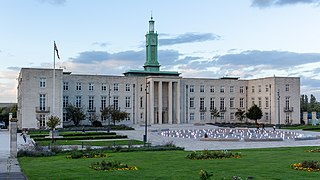
Walthamstow is a town within the London Borough of Waltham Forest in East London. The town borders Chingford to the north, Snaresbrook and South Woodford to the east, Leyton and Leytonstone to the south, and Tottenham to the west. At the 2011 census, Walthamstow had a population of approximately 109,424 and is around 7.5 miles (12 km) north-east of Central London.

The London Borough of Waltham Forest is an outer London borough formed in 1965 from the merger of the municipal boroughs of Leyton, Walthamstow and Chingford.
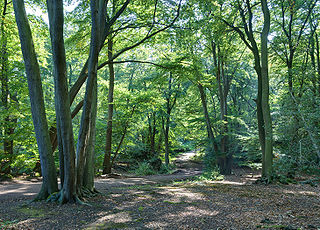
Epping Forest is a 2,400-hectare (5,900-acre) area of ancient woodland, and other established habitats, which straddles the border between Greater London and Essex. The main body of the forest stretches from Epping in the north, to Chingford on the edge of the London built-up area. South of Chingford the forest narrows, and forms a green corridor that extends deep into east London, as far as Forest Gate; the forest's position gives rise to its nickname, the Cockney Paradise. It is the largest forest in London.

Lea Bridge is a district in the London Borough of Hackney and the London Borough of Waltham Forest in London, England. It lies 7 miles (11.3 km) northeast of Charing Cross.

Waltham Abbey is a town and civil parish in the Epping Forest District of Essex, within the metropolitan and urban area of London, England, 13.5 miles (21.7 km) north-east of Charing Cross. It lies on the Greenwich Meridian, between the River Lea in the west and Epping Forest in the east, with large sections forming part of the Metropolitan Green Belt.

East London is the northeastern part of London, England, east of the ancient City of London and north of the River Thames as it begins to widen. Containing areas in the historic counties of Middlesex and Essex, East London developed as London's docklands and the primary industrial centre. The expansion of railways in the 19th century encouraged the eastward expansion of the East End of London and a proliferation of new suburbs. The industrial lands of East London are today an area of regeneration, which are well advanced in places such as Canary Wharf and ongoing elsewhere.
Highams Park is a district in the London Borough of Waltham Forest, England, near Epping Forest and 8.1 miles (13 km) north-east of Charing Cross.
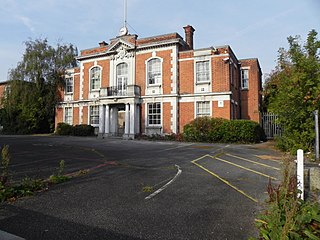
Chingford was a local government district in south west Essex, England from 1894 to 1965, around the town of Chingford. It was within the London suburbs, forming part of the London postal district and Metropolitan Police District. Its former area now corresponds to the northern part of the London Borough of Waltham Forest in Greater London.
The Lea Valley, the valley of the River Lea, has been used as a transport corridor, a source of sand and gravel, an industrial area, a water supply for London, and a recreational area. The London 2012 Summer Olympics were based in Stratford, in the Lower Lea Valley. It is important for London's water supply, as the source of the water transported by the New River aqueduct, but also as the location for the Lee Valley Reservoir Chain, stretching from Enfield through Tottenham and Walthamstow.
Chingford was a parliamentary constituency centred on the town of Chingford in the London Borough of Waltham Forest. It returned one Member of Parliament (MP) to the House of Commons of the Parliament of the United Kingdom by the first past the post system.
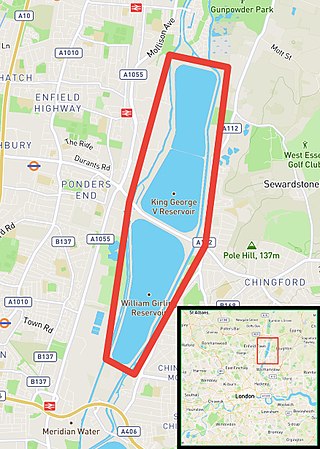
The Chingford Reservoirs are the King George V Reservoir and the William Girling Reservoir, which form part of the Lee Valley Reservoir Chain in the London Boroughs of Enfield and Waltham Forest and Epping Forest in Essex. Construction of the King George V Reservoir was started in 1908 and completed in 1912. Work on the William Girling Reservoir was started in 1938, with John Mowlem & Co being the contractor, but owing to technical problems, and the intervention of World War II, the reservoir was not finished until 1951.

Pymmes Brook is located in North London and named after William Pymme, a local land owner. It is a minor tributary of the River Lea. The brook mostly flows through urban areas and is particularly prone to flooding in its lower reaches. To alleviate the problem the brook has been culverted in many areas. Part of it is a Site of Borough Importance for Nature Conservation, Grade II.

Salmons Brook is a minor tributary of the River Lea, located in the London Borough of Enfield.

The Small River Lea is a minor tributary of the River Lea, which flows through the Lee Valley Park between Cheshunt and Enfield Lock. It forms part of the Turnford and Cheshunt Pits Site of Special Scientific Interest (SSSI) as it flows through the River Lee Country Park.
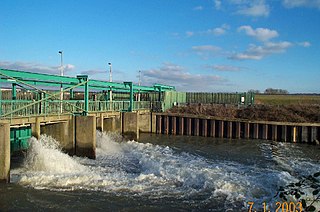
The Lee Flood Relief Channel (FRC) is located in the Lea Valley and flows between Ware, Hertfordshire, and Stratford, east London. Work started on the channel in 1947 following major flooding and it was fully operational by 1976. The channel incorporates existing watercourses, lakes, and new channels. Water from the channel feeds the Lee Valley Reservoir Chain.

Cuffley Brook is a tributary of Turkey Brook. It runs through parts of Hertfordshire and the London Borough of Enfield, England. After the confluence of the two streams in Whitewebbs Park, the watercourse continues eastwards as Turkey Brook to join the River Lea near Enfield Lock.

The Lee Valley Reservoir Chain is located in the Lee Valley, and comprises 13 reservoirs that supply drinking water to London.

Deephams Sewage Treatment Works is a sewage treatment facility close to Picketts Lock, Edmonton, England. The outflow discharges via Pymmes Brook into the River Lee Navigation at Tottenham Lock. The treatment works was upgraded in 2012/13.
Hawkwood is a 25-acre estate in North Chingford, London Borough of Waltham Forest, North East London, England. It is about nine miles from central London, in the fertile Lea Valley on the western edge of Epping Forest. In the 19th century it formed the grounds of a large Elizabethan-style Victorian mansion, seat of Richard Hodgson, lord of Chingford St. Pauls. The mansion became derelict after bomb damage in 1944 and was demolished in 1951. Part of the site is now a nature reserve, a special school has been built on another part, and a large part of the site is being used by OrganicLea, a workers' cooperative growing and selling food and providing horticultural training.